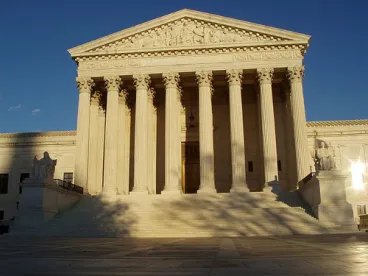In one of the most-anticipated decisions of the Term, the Supreme Court on Monday unanimously reversed the Fifth Circuit’s decision interpreting the “fraud on the market” theory in Halliburton Co. v. Erica P. John Fund, Inc. However, the unanimous reversal does not mask the sharp divisions on the Court regarding the propriety of the controversial theory in securities class action litigation. In fact, reversing the lower court was one of the few things on which all the Justices could agree. While Chief Justice Roberts’ majority decision puts to rest, for now, questions about the continued vitality of the theory, the fractured opinion also highlights future interpretive issues surrounding the theory’s application.
The tortuous route to yesterday’s decision began fifteen years ago when Halliburton allegedly made misstatements about its potential liability in asbestos cases, among other things, in an effort to inflate its stock price. After Halliburton corrected those misstatements, its stock price dropped and a securities class action suit under Section 10(b) of the Securities Exchange Act of 1934 and Rule 10b-5 inevitably followed. The lead plaintiff sought to certify a class of investors, but the district court refused because plaintiff had not proven “loss causation,” i.e., that the alleged misrepresentations proximately caused the investors’ losses. After the Fifth Circuit affirmed, the Supreme Court in 2011 vacated the district court’s decision. In its first Halliburton case, the Supreme Court concluded that its precedents, particularly Basic, Inc. v. Levinson, which first adopted the “fraud on the market” theory in 1988, did not require plaintiffs to prove loss causation at the class certification stage in order for plaintiffs to invoke the “fraud on the market” theory’s presumption that investors who purchased securities before the corrective disclosures were harmed by the alleged misstatements because Halliburton’s stock traded in an “efficient” market. The Court then sent the case back to the district court to revisit the class certification question.
Back in district court, Halliburton argued again that a class should not be certified. It argued that the alleged misstatements had not actually affected its stock price, and the absence of any “price impact” meant that plaintiffs had not relied on those misstatements simply by buying shares at the market price. Consequently, plaintiffs could not utilize the “fraud on the market” theory’s presumption of reliance and would instead have to prove reliance individually, which would prevent class certification because individual issues would predominate over class-wide issues. The district court, and then the Fifth Circuit, disagreed with Halliburton. The Fifth Circuit reasoned that “price impact evidence” could only be introduced at the merits stage, after class certification, because it did not relate whether common questions predominated.
Halliburton’s appeal to the Supreme Court raised two issues. First, Halliburton raised the threshold question of whether Basic’s “fraud on the market” presumption of reliance should be overturned. Second, it raised the narrower question of whether defendants could rebut Basic’s presumption of reliance by demonstrating that any alleged misstatements actually did not impact the stock price. Because overturning Basic and its “fraud on the market” theory could potentially eviscerate securities class action lawsuits, securities practitioners, public companies, and the twenty-three groups of amici have watched this case with great interest.
The Court’s unanimous reversal of the Fifth Circuit’s decision actually lumps together three divergent views of the “fraud on the market” theory – the Chief Justice’s, the more liberal wing of the Court (Ginsburg, Breyer and Sotomayor), and the more conservative wing (Thomas, Scalia and Alito).
Chief Justice Roberts’ majority opinion embraced Basic’s continued validity, both as a matter of stare decisis and on the merits. The Chief Justice wrote that Halliburton had not presented the “special justification” needed for the Court to overturn its prior precedent. Specifically, Halliburton argued that the efficient market hypothesis, which undergirds the “fraud on the market” theory, has come under increasing criticism as academics have shown that markets do not always incorporate new information efficiently for even large, widely-held stocks. It also challenged Basic’s assumption that investors rely on the integrity of the market price so that, if that price has been distorted by a public misstatement, investors trading on that information have been harmed. Halliburton pointed to various categories of investors, like value investors, who often invest irrespective of market price or based on the belief that the market has incorrectly valued a company’s shares.
Chief Justice Roberts dismissed these arguments. He said that even Basic acknowledged that market efficiency was a “matter of degree” and therefore “a matter of proof.” He also argued that the existence of value investors did not undercut Basic’s premise that investors generally care about market price integrity. The Chief Justice also noted that Congress has amended Section 10(b) twice since Basic without correcting Basic’s interpretation of the “fraud on the market” theory. Such Congressional acquiescence, he said, buttressed the idea that Basic was correctly decided. Finally, the Chief Justice dismissed arguments about the harmful effects of securities class actions as being more appropriately directed to Congress.
The Chief Justice agreed with Halliburton, however, that defendants can rebut the reliance presumption at the class certification stage by showing the lack of a price impact, rather than only at the merits stage. Without a price impact, he said, “Basic’s fraud-on-the-market theory and presumption of reliance collapse.” There is no basis for plaintiffs to argue that a misstatement is reflected in the share price when a transaction occurs and presume reliance and certify a class.
Plaintiffs need not prove price impact directly as Halliburton had also argued; demonstrating it indirectly by showing that the misstatement was public, material, and that the stock trades in a generally efficient market, suffices. However, a defendant then gets to demonstrate directly that the alleged misrepresentation(s) did not move the stock’s price, in addition to refuting the “indirect proxies” for price impact (i.e., market efficiency, a public, material misstatement, and the like). Because Halliburton was prohibited from doing so, the majority concluded that the Fifth Circuit’s decision must be reversed.
Three justices (Ginsburg, Breyer and Sotomayor) concurred separately to affirm Basic and explain their belief that their decision principally impacted defendants because “it is incumbent upon the defendant to show the absence of price impact.” In their view, the decision “should impose no heavy toll on securities-fraud plaintiffs with tenable claims” though it could hasten arguments about price impact and expand discovery at class certification.
These comments seem to minimize how this decision will impact plaintiffs. That they felt compelled to write separately suggests that this view was not shared by the other three justices in the majority. It suggests further that the Chief Justice (along with Justices Kennedy and Kagan) believe that the reliance presumption is not at all conclusive as has often been the case. Instead, defendants have a real opportunity to prevent class certification by “severing the link” between the alleged misrepresentation and the price paid (or received) by the plaintiffs. If so, event studies and other analyses often employed by parties at class certification to demonstrate or disprove market efficiency may take on greater importance as tools for defendants to defeat class certification.
The other three justices (Thomas, Scalia and Alito) concurred in the judgment only. They agreed that the Fifth Circuit erred, but they stated bluntly that “Basic should be overruled.” They argued that Basic was wrongly decided in the first instance and that stare decisis was no reason to uphold Basic when “logic, economic realities, and [the Court’s] subsequent jurisprudence” had undermined its rationale. Justice Thomas’s concurrence disputed each of the majority’s positions in support of “Basic’s muddled logic and armchair economics.” He argued that Basic’s view of market efficiency “has since lost its luster” for even well-developed markets, citing studies showing that even those markets do not always “uniformly incorporate information into market prices with high speed” or even accurately. He also criticized the belief that investors rely on the integrity of market price, asserting that “many investors do not buy or sell stock based on a belief that the stock’s price accurately reflects its value” and in fact believe the opposite. Without these foundational assumptions, “Basic’s critical fiction falls apart.”
This concurrence also disputed the Chief Justice’s belief that the reliance presumption can be rebutted. Justice Thomas stated that “the realities of class-action procedure make rebuttal based on an individual plaintiff’s lack of reliance virtually impossible” even if many class members did not actually rely on the integrity of the market price when buying (or selling) their shares. This reality both strays from Basic’s premise and exempts securities fraud plaintiffs from the Court’s more recent Rule 23 case law, like Wal-Mart and Comcast, which require plaintiffs to prove that individual issues do not predominate over common issues. By eliminating plaintiffs’ obligation to show that each plaintiff relied on the alleged misrepresentation, Justice Thomas argued, Basic skirts Rule 23’s obligations.
Justices Thomas, Scalia and Alito therefore advocated for adopting the “actual reliance” requirement other fraud causes of action have which would effectively end the use of class actions as vehicles to pursue Section 10(b) claims. And because the Court created the “fraud on the market” presumption, he argued that it remained the Court’s responsibility to correct it. The tenor of this concurrence, including its dismissal of stare decisis, strongly suggests that these justices will view Basic as wrongly decided if this issue is raised with the Court again.
Halliburton might be viewed as one of the Chief Justice’s Solomonic decisions. Conflicting views about Basic’s logic among the justices nonetheless yielded a “unanimous” outcome. Neither party got exactly what it sought. Plaintiffs retained the presumption that makes securities fraud class actions possible, but successfully pursuing those claims has become harder and probably more expensive. How much so is obviously unclear. Class certification motion practice will take on even more significance. The first time a district court denies class certification because a defendant’s event study shows that an alleged misstatement did not impact the stock’s price could provide additional insights (or beginHalliburton III).




 />i
/>i

